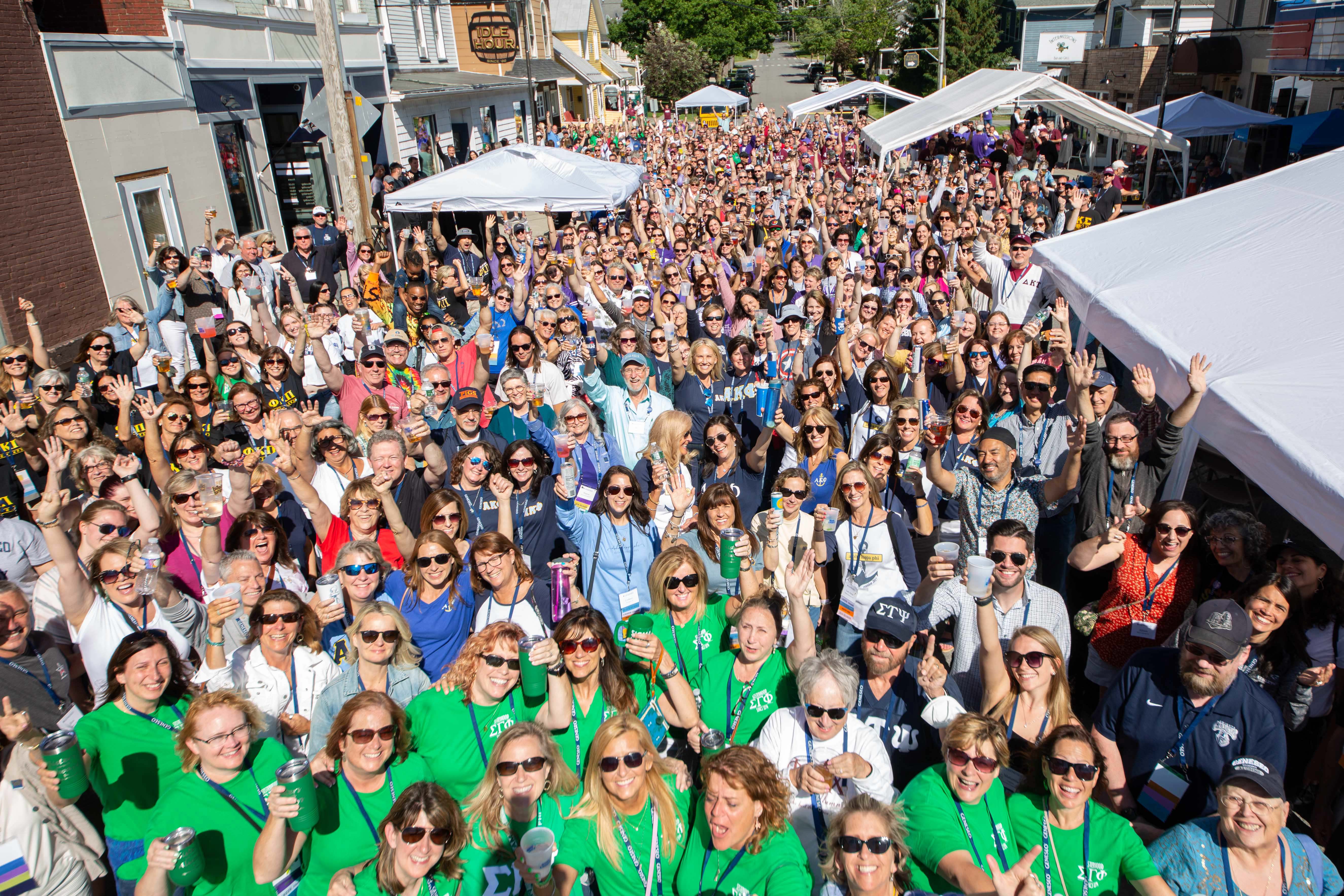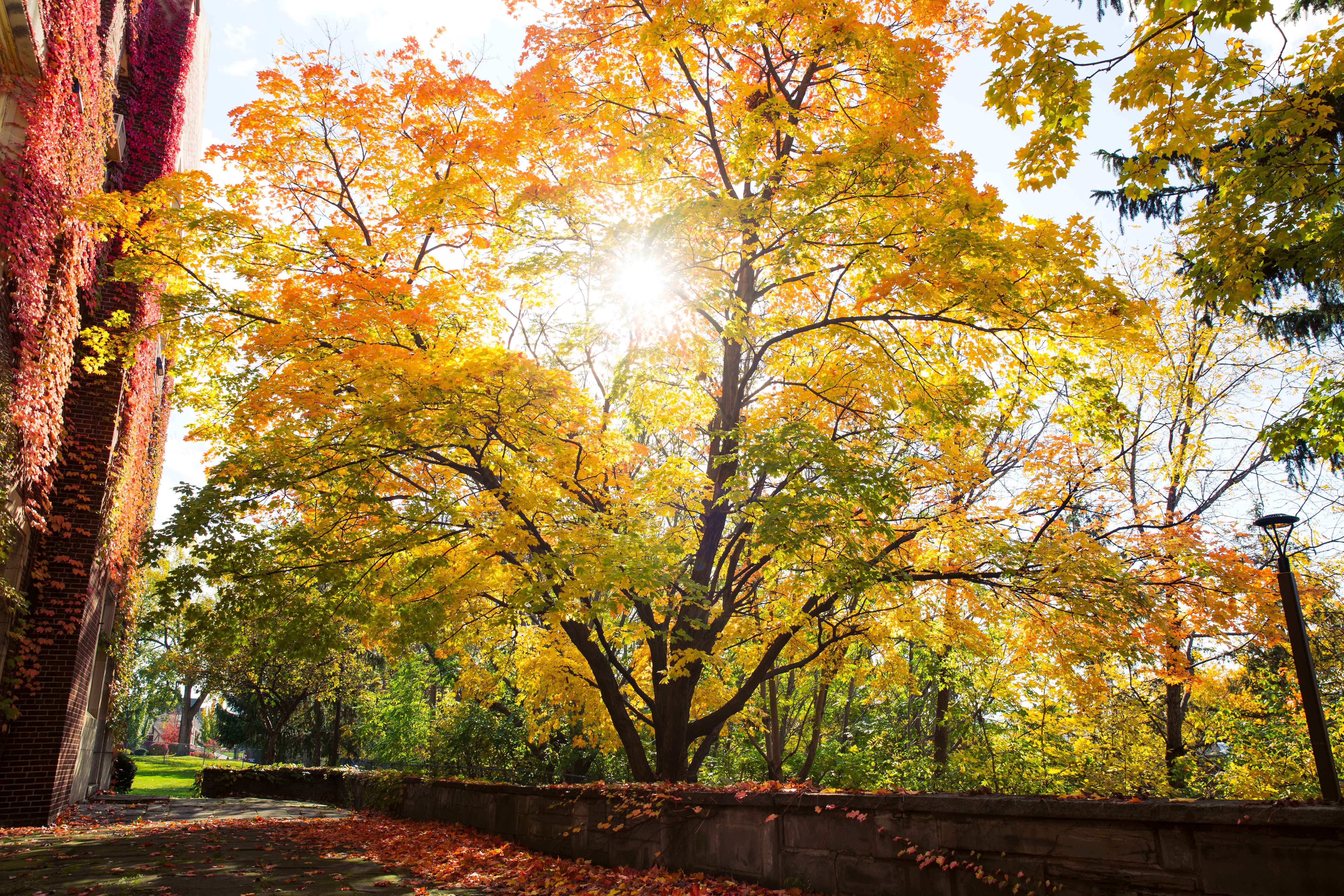
By Merrill Douglas | Illustrations by Davide Bonazzi
Geneseo researchers explore the connections between people and place.
It’s not hard to figure out your location on the map. Nowadays, you can just ask your phone. Understanding what it means to be in that location is a different story.
The character of a place (Hilly or flat? Bustling or deserted? Settled in the 1890s or the 1980s?) shapes your experience there, and maybe even shapes the person you are. Whether you’ve lived in a place all your life, you’re walking its streets for the first time, or you’ve just stopped in to grab a coffee, you and the place you inhabit are never completely distinct. Faculty researchers at SUNY Geneseo are investigating the complex interrelationships between people and place, one through the lens of geography and the other through neuroscience and psychology.
American Road Trip
For Darrell Norris, professor of geography, the laboratory for exploring the intersection of people and place is U.S. Route 20. Close to Geneseo, passing about 10 miles north of campus, this road stretches 3,400 miles, from Fenway Park in Boston to just short of the Pacific Ocean in Oregon.
“Of all the east-west transcontinental highways that were part of the first federal highway program in 1926, the only one that has survived intact is U.S. Highway 20,” Norris says.
In the late 1980s, a grant from what is now the American Association of Geographers sent Norris out on his first survey of Route 20. He’s been driving back and forth on that highway ever since, collecting observations and bringing back discoveries to share with his students.
Norris’s first goal on Route 20 was to study “the roadside museum of the automobile” — the human-built landscape of gas stations, motels, drive-in movies, diners, and other auto-oriented businesses.
The age, design and placement of those facilities tell a lot about the needs of travelers in different eras, Norris says. “How large are the motels? Are there any particular kinds of locations? Do they benefit from being close to one another? All sorts of questions arise from the constraints on the car and the driver — the size of the gas tank, of their bladder, their hunger, their exhaustion.”

Illustration by Davide Bonazzi
One early inquiry focused on defunct gas stations. “Before the Environmental Protection Agency (EPA) put its foot down about underground tanks, about three-quarters of all gas stations were reused for other purposes, some of them quite interesting purposes, such as churches,” Norris says. He found that a station’s architectural form and age helped to determine how people would repurpose the building.
At Geneseo, Norris supervises 10 to 12 directed study students every year, some of whom conduct similar explorations of the built environment. This year, for example, honors thesis student Sam Gallivan ’18 is researching the rise and fall of bowling alleys in the Rust Belt of the Northeastern United States.
For readers who want to see for themselves what the built environment reveals about a small town, Norris suggests a drive down a two-lane federal highway in the western U.S., where Main Streets commonly run at a right angle to the highway. “The trick is to slow down and turn in to savor a lost world, the long-defunct circa 1920 bank, the ‘boomtown’ false fronts, the empty school a block or so off Main Street, and so on. The dead gas station will be on the main highway and often fairly intact. The motels have usually been torn down. A sure sign of a former gas station is ground evidence of the former island, and the underground tanks.”
Over time, Norris has shifted focus from Route 20s buildings to its people, especially the residents of small towns in “flyover country,” the central region of the United States, that people from the coasts cross over on transcontinental flights but rarely visit. Many of these towns have been losing population since the 1920s or 1930s. In Nebraska and other states in the High Plains, Norris talks with people and studies where they live, trying to understand — among other questions — why so many towns are dwindling, why people in those communities vote as they do, and which small places are most likely to survive.
Many of the shrinking towns suffer from severe isolation. Often, the nearest Walmart is more than two hours away, the only restaurant is a bar and grill, and the closest thing to a grocery store is a gas station mini-mart. “In the middle of one of the most productive agricultural areas of the world, ordinary folks are in a food desert,” Norris says.
But some people are determined to keep their communities alive. Take Burns, in eastern Oregon, population 2,086 as of the 2010 census.
“It’s the kind of place that could be expected to lose population, and particularly to lose its young,” Norris says. But the people of Burns have joined forces to keep the town attractive. “Burns subsidizes its cinema; it subsidizes the café. It has what appears to be one of the most successful county fairs in Oregon.”
To maintain services on a tiny budget, many professionals and managers in Burns work two or three jobs. “You might be running the visitors’ center but working in the library as well. You might be deputy sheriff but also run a small business,” Norris says.
Or take Newport, Neb., whose last store — Myrnas Market — was closing for good the day Norris visited, in 2009. At that time, Newport’s school — built for kindergarten through eighth grade — served only seven students. As Norris stopped by at the end of the school day, two of those students emerged from the building.
“They walked to the flag pole and very solemnly took down and folded the American flag,” he says. “I could not keep a dry eye as I watched. The kids had given no impression that they felt left out of the school experience most young Americans are exposed to. Indeed, they took pride in their school, and the flag seemed to capture that sentiment.”
Such displays of courage and resolve are what keep Norris interested in his research, he says. “I’m trying to work on understanding and sharing what I see,” he said.
The Map in the Mind
While Norris examines what makes small places tick, Jason Ozubko, assistant professor of psychology, is trying to learn what’s ticking in our brains as we recall the details of a place. Ozubko recently received a three-year, $370,245 Academic Research Enhancement Award from the National Institute of Neurological Disorders and Stroke (NINDS) to support this work, which could someday lead to new methods for slowing the decline of spatial memory as people age.
Based on decades of research with rodents, scientists know that when an animal negotiates a maze, its knowledge of that space resides in “place cells” within the hippocampus. “This area seems to be important for representing not only where you are, if you’re a rat, but also where you’re planning to go,” Ozubko says. As an animal rests after navigating a maze, scientists observe activity in the place cells. “It’s as if the rat were thinking about walking through the maze.”
Ozubko’s project extends this line of study to humans, asking how people absorb information about where they are, remember that information, and later use it to find their way.
To study this topic, Ozubko and the Geneseo undergraduates who work in his lab are taking volunteers — all Geneseo undergraduates — to a neighborhood in Pittsburgh that they’ve never visited before, using software with a first-person perspective based on Google Map’s Street View. Over several days, subjects “walk” various virtual routes, observing landmarks and taking quizzes along the way to see if they know where to turn next.
“We’re trying to see what the consequences of the training are and to understand if subtle changes in how we train people could lead to very different representations in their heads about that space,” Ozubko says.
When the training is done, half the subjects take quizzes that prompt them to think in new ways about where they have been. For example, how would they navigate backward, from destination to origin? Or which of two images did they see first as they traveled the route? The rest of the subjects simply answer questions about what they saw, with no need to consider how different spaces connect.
Finally, the researchers challenge all the subjects to generate novel routes — for instance, to navigate from the start of path A to the end of path C. “We’re interested in seeing if the first group, which gets the quizzes about connections in space, develops more sophisticated map representations of the space,” Ozubko says. With those mental maps, a subject might figure out efficient shortcuts and find effective ways to deal with roadblocks that researchers insert.
For Luke Bambrowski ’19, who works in Ozubko’s lab, one fascinating aspect of this study is what it might reveal about the role of spatial memory in certain neurodegenerative conditions.
“For example, in Alzheimer’s disease, spatial memory is one of the first things to go,” he says. “As we develop an understanding of memory, we develop a better understanding of how we can intervene in these disorders and improve the human condition.”
Bambrowski and another student researcher, Molly Brady ’19, received a Research and Travel Grant through the Geneseo Foundation that launched the project; they have also helped to shape the research methodology. For example, they conducted the difficult search for a geographical location that would meet all study’s criteria. Once they found it, they developed the virtual routes. Ozubko has also received support through The Geneseo Foundation for research. A future phase of the research might use virtual reality to fully immerse subjects in a location, Brady says. And that technology could someday offer interesting possibilities for patients with dementia, maybe allowing them to virtually walk routes they knew in the past, she says. “It would be interesting to see if that would have any impact on aspects of their lives such as excitement or joy, or if it enhances their ability to remember.”
Ozubko says that as far as he knows, this is the first time a long-term training study has used a realistic virtual environment, based on an actual place, to study spatial representations in the brain.
When the study is complete, Ozubko and his team will write up the results for publication in a peer-reviewed journal. They also hope to use what they’ve learned from working with young, healthy subjects to expand the research to older adults, or to people with specific navigational problems. “This would be to help us learn how the brain represents space and how those representations break down, but also to think about ways we could circumvent navigational difficulties in those experiencing them,” he says.
Although the lab’s current research aims mainly at scientific discovery, perhaps similar navigational exercises could someday help older people strengthen their memories, Ozubko says. “It’s possible that something like this could spur individuals to get lost less often, to develop more sophisticated mental maps, or maybe just slow down the onset of some kinds of dementia.”










